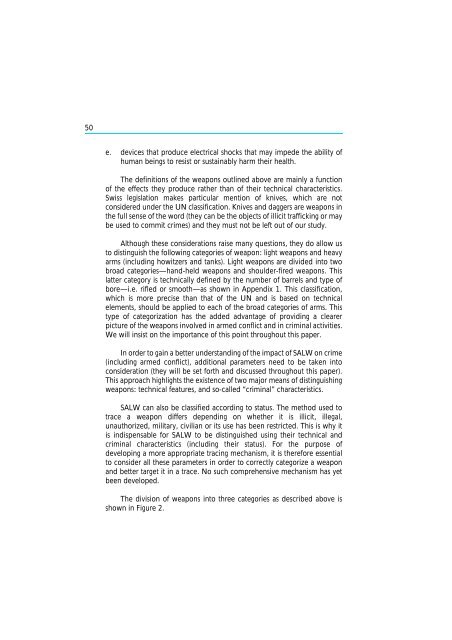The Scope and Implications of a Tracing Mechanism for Small Arms ...
The Scope and Implications of a Tracing Mechanism for Small Arms ...
The Scope and Implications of a Tracing Mechanism for Small Arms ...
Create successful ePaper yourself
Turn your PDF publications into a flip-book with our unique Google optimized e-Paper software.
50<br />
e. devices that produce electrical shocks that may impede the ability <strong>of</strong><br />
human beings to resist or sustainably harm their health.<br />
<strong>The</strong> definitions <strong>of</strong> the weapons outlined above are mainly a function<br />
<strong>of</strong> the effects they produce rather than <strong>of</strong> their technical characteristics.<br />
Swiss legislation makes particular mention <strong>of</strong> knives, which are not<br />
considered under the UN classification. Knives <strong>and</strong> daggers are weapons in<br />
the full sense <strong>of</strong> the word (they can be the objects <strong>of</strong> illicit trafficking or may<br />
be used to commit crimes) <strong>and</strong> they must not be left out <strong>of</strong> our study.<br />
Although these considerations raise many questions, they do allow us<br />
to distinguish the following categories <strong>of</strong> weapon: light weapons <strong>and</strong> heavy<br />
arms (including howitzers <strong>and</strong> tanks). Light weapons are divided into two<br />
broad categories—h<strong>and</strong>-held weapons <strong>and</strong> shoulder-fired weapons. This<br />
latter category is technically defined by the number <strong>of</strong> barrels <strong>and</strong> type <strong>of</strong><br />
bore—i.e. rifled or smooth—as shown in Appendix 1. This classification,<br />
which is more precise than that <strong>of</strong> the UN <strong>and</strong> is based on technical<br />
elements, should be applied to each <strong>of</strong> the broad categories <strong>of</strong> arms. This<br />
type <strong>of</strong> categorization has the added advantage <strong>of</strong> providing a clearer<br />
picture <strong>of</strong> the weapons involved in armed conflict <strong>and</strong> in criminal activities.<br />
We will insist on the importance <strong>of</strong> this point throughout this paper.<br />
In order to gain a better underst<strong>and</strong>ing <strong>of</strong> the impact <strong>of</strong> SALW on crime<br />
(including armed conflict), additional parameters need to be taken into<br />
consideration (they will be set <strong>for</strong>th <strong>and</strong> discussed throughout this paper).<br />
This approach highlights the existence <strong>of</strong> two major means <strong>of</strong> distinguishing<br />
weapons: technical features, <strong>and</strong> so-called “criminal” characteristics.<br />
SALW can also be classified according to status. <strong>The</strong> method used to<br />
trace a weapon differs depending on whether it is illicit, illegal,<br />
unauthorized, military, civilian or its use has been restricted. This is why it<br />
is indispensable <strong>for</strong> SALW to be distinguished using their technical <strong>and</strong><br />
criminal characteristics (including their status). For the purpose <strong>of</strong><br />
developing a more appropriate tracing mechanism, it is there<strong>for</strong>e essential<br />
to consider all these parameters in order to correctly categorize a weapon<br />
<strong>and</strong> better target it in a trace. No such comprehensive mechanism has yet<br />
been developed.<br />
<strong>The</strong> division <strong>of</strong> weapons into three categories as described above is<br />
shown in Figure 2.
















